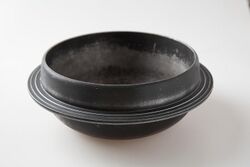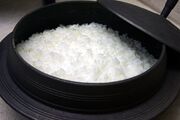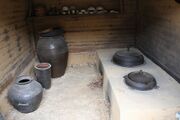Engineering:Gamasot
| Gamasot | |
 | |
| Korean name | |
|---|---|
| Hangul | 가마솥 |
| Revised Romanization | Script error: The function "transl" does not exist. |
| McCune–Reischauer | Script error: The function "transl" does not exist. |
| IPA | ka.ma.sot̚ |
| Alternate name | |
| Hangul | 솥 |
| Revised Romanization | Script error: The function "transl" does not exist. |
| McCune–Reischauer | Script error: The function "transl" does not exist. |
| IPA | sot̚ |
Script error: The function "transl" does not exist. (Korean: 가마솥), or simply Script error: The function "transl" does not exist. (솥), is a large, heavy pot or cauldron commonly used in Korean cuisine.[1][2]
Origin
The modern Korean Script error: The function "transl" does not exist. descends from the ancient jeong (鼎), which is made of bronze.[3] Bronze sot are frequently unearthed as remains of the Three Kingdoms period, because the jeong was symbolic of the nation, the throne, and industry. However, the history of the iron sot goes back much earlier than the Three Kingdoms period .[3] The copper sot on the Korean Peninsula were first discovered in the remains of Gojoseon, which corresponds to the Liaoning bronze dagger culture of the late Bronze Age. A large number of sot were excavated from the ruins of the Four Commanderies of Han, which was installed when Gojoseon was destroyed by Han in 108 BCE. In particular, the ruins of the Lelang Commandery are famous for the being the source of the largest variety of pots.[3]
Shape
It was very large and recessed to fit the large family of Korea. In general, gama mean utensils when lighting a fire, and Script error: The function "transl" does not exist. means pot and bowl that cook rice. The Script error: The function "transl" does not exist. has no legs and the bottom of the pot is round and usually has a small recess at the edge of the entrance. There are four projections on the body, which is convenient to put across the stove. The lid is made of iron, and it has a convenient tap in the middle.[4]
History
From ancient times, the pot was not simply a device for cooking food, but a symbol of kingship, power, state, and industry.[5] It was used as a tool to record the achievements of public figures or to punish corrupt officials, religious ceremonies, or food for the dead.
Cooking rice in Script error: The function "transl" does not exist. is a longstanding custom in Korea, that began at least during the reign of King Daemusin (18‒44 CE) in Goguryeo.[2]
Usage
In the hanok's kitchen, agungi can be used for heating and cooking, and Script error: The function "transl" does not exist. is a large pot designed for use as a cooking utensil. Script error: The function "transl" does not exist. is very large, so it is common to use it almost fixed to agungi. Script error: The function "transl" does not exist. is a Korean traditional pot that has kept its kitchen for a long time. There were few places where it is not used, such as making fire, cooking rice, frying the side dishes and steaming. The closest thing to real life was Script error: The function "transl" does not exist.. It is an important cooking tool that can not be used for cooking in Korea. Therefore, the pot was a history of the family.[6]
Gallery
Script error: The function "transl" does not exist. & agung-i
See also
Extra-large Gamasot
In July 2005, Goesan-gun, Chungcheongbuk-do completed an extra-large Script error: The function "transl" does not exist. with over 500 million won in military budget and resident's contribution. The super-sized Script error: The function "transl" does not exist. is 17.85 meters in circumference, 2.2 meters in height, 5.88 meters in diameter, and weighs 43.5 tons.[7] This Script error: The function "transl" does not exist. is located in Goesan-eup Dongbu Clean Chilli Distribution Center. In the pot lid there are inscriptions of ascending dragons, turtles and Mugunghwa.[1] It is said that Goesan-gun could build 40,000 people of rice at a time, but he could not do it, and he only stewed 10,000 corns.[7] Goesan-gun applied for the Guinness Book of World Records as the world's largest cauldron, but abandoned the promotion of the Guinness Book by the fact that the earthenware of Australia was bigger. Also, Goesan - gun has not used this super - sized cauldron since 2007 and has neglected it.[8] So, Goesan - gun tried to find out how to utilize the super - sized cauldron with various meanings of the people, and finally decided to leave it for publicity.[9]
See also
References
- ↑ Jump up to: 1.0 1.1 "gamasot". National Institute of Korean Language. https://krdict.korean.go.kr/eng/dicSearch/SearchView?nation=eng&ParaWordNo=15374.
- ↑ Jump up to: 2.0 2.1 Pettid, Michael J. (2008). Korean Cuisine: An Illustrated History. London: Reaktion Books. pp. 34. ISBN 978-1-86189-348-2. https://books.google.com/books?id=wzJ7_WcLJSwC&pg=PA34.
- ↑ Jump up to: 3.0 3.1 3.2 "가마솥에 숨겨진 과학 '무쇠솥'과 '통가열식 압력밥솥'" (in ko). https://terms.naver.com/entry.nhn?docId=3340365&cid=58163&categoryId=58163.
- ↑ "한국인의 솔푸드 '가마솥밥' 지어볼까" (in ko). 2010-09-16. http://www.hani.co.kr/arti/specialsection/esc_section/440091.html.
- ↑ 국립민속박물관. "솥 - 표제어 - 한국민속신앙사전 - 한국민속대백과사전" (in ko). http://folkency.nfm.go.kr/kr/topic/%EC%86%A5/2423.
- ↑ "무쇠솥으로 지은 밥은 왜 맛있을까 | d라이브러리" (in ko). http://mdl.dongascience.com/magazine/view/S200404N046.
- ↑ Jump up to: 7.0 7.1 "솥" (in ko). https://terms.naver.com/entry.nhn?docId=1114875&cid=40942&categoryId=32154.
- ↑ "애물단지 '세계 최대 괴산 가마솥'…어이할꼬" (in ko). http://news.naver.com/main/read.nhn?mode=LSD&mid=sec&sid1=102&oid=028&aid=0002365240.
- ↑ "괴산군민 가마솥, 전시 홍보용으로 존치" (in ko). 충청매일. 2017-06-25. http://www.ccdn.co.kr/news/articleView.html?idxno=468519.
 |













